.
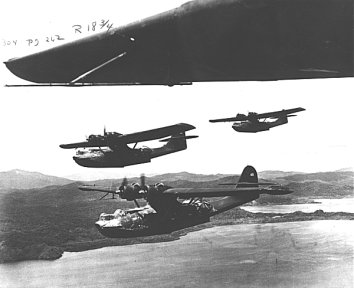
A rare photo of Catalinas in formation taken during the war.
They were sent to me by Norm Muffitt retired RCMP Pilot,
his Father was lost flying one. ~ Ted Hackett
Norm Muffitt
mufftoon@telusplanet.net
“My dad started out in Northern Ireland on Sunderlands
with 201 Squadron and then went over to the Catalinas with 131 OTU.
He was reported missing in Nov 1943.
This past year we have learned more about his life overseas
in Coastal Command than the family had learned in all the years prior.
The group I have been writing to in Ireland are without a doubt true experts
on Coastal Command activities out of Ireland. The one chap is a real
wealth of information and I know he would be thrilled to correspond with
any ex Coastal type..
THE CRASH OF CANSO 9789
Ed. For non-Coastal Command types, add landing gear
to a Catalina, make it amphibious, Voile! You have a Canso
Sharon Brown, the daughter of the late Ken Brown is working
on a biography of her father and sent information regarding the crash of
Canso 9789. Ken Brown was the Second Pilot on the crew.
The book Sharon refers to is JERICO BEACH and the West
Coast Flying Boat Squadrons, by Chris Weicht. ISBN 0-9681 158-0-2
February 1997.
Dad’s Crash
On page 125 is the story about the crash that Dad was
in. He always told it as the Captain insisted on going in a certain
direction (about which Dad reportedly had his doubts) and they hit the
mountain after taking off about a 1/4 mile of treetops. These are
the crash pictures I'm sending when I get my act together here hopefully
tomorrow. On page 125 it says that Joseph "turned to the left" and when
I read that I thought that's got to be the same crash. I'd been looking
for it on the internet aviation crash sites but had no specifics.
The plane certainly was totalled as the book says. Dad always mentioned
there was one person killed who was in a small turret or something [gun
blister]. The book says it was Cowman, a flight engineer. Dad
said he was wandering around when help arrived and was told his eyes looked
like 2 little pinpoints. They suggested a short leave so he went
all the way by train back to Mount Forest (Ont.), stayed one day, then
returned by train to Bella Bella, BC. He said he was always able
to get a sleeping berth by treating (bribing?) the conductor right.
JERICO BEACH Page 125 – Category “A” crash 30-7-43 Alarm
Cove, #9 BR Squadron, Bella Bella BC.
On July 9th, 1943, the Squadron received its second Canso,
#9789.
On patrol July 25th, her crew sighted a submarine 175
miles West of the Queen Charlotte Islands. The aircraft was at 4,000 feet
and made a rapid descent through cloud to attack. When they broke out under
the cloud deck at 2,000 feet, the submarine had disappeared and nothing
further was seen.
The stations first fatal flying accident occurred on July
30, 1943, when Canso #9789 left Bella Bella on an extra long patrol, but
ran into fog in Lama Passage and lost contact with the surface. The Pilot,
P/O A.J. Joseph, attempted a left turn back to the station. The aircraft,
weighted down with a heavy load of fuel, was unable to climb above the
fog or to negotiate the turn in the narrow passage. Number 9789 lost altitude
and crashed into the side of a mountain on Denny Island, on the East side
of Lama Passage above Alarm Cove. The aircraft caught fire on impact killing
the Flight Engineer Sgt. J.A. Cowman and injuring the remaining 8 crew
members. The Canso was totally destroyed.
Although there were a number of Submarine sightings
on the West Coast, the greatest enemy faced by the flying boat crews was
the weather.
Your Editor had the privilege of being crewed up with
Ken Brown on Sunderlands at Alness Scotland and 422 Squadron, Pembroke
Dock, South Wales. Ken had a tremendous sense of humour. When tense situations
arose he always had a comment to break the tension. Maybe that was a result
of the Canso crash.
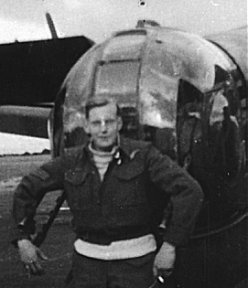
Carman Brown 429 “Bison” Squadron
Leeming, York. August/44
Carman Brown
LONDON TOWN
(Salisbury steak)
Do you remember your very first leave after arriving in
Bournemouth, trying to comprehend all those funny names for the English
currency pound, quid, florin, ½ crown, shilling, pence etc.?
Having teamed up with a city slicker from Toronto, named
Alan Roach, I from a small town in Eastern Ontario called Prescott and
situated on the St. Lawrence river, with a population of 3000 souls, we
headed for London and used the “Nuffield Hostels” as our staging point.
We had a good time taking in all known sites and dropping numerous little
silver coins into an electric/gas heater in order to warm our room. We
all know about London fog, London rain, London pubs and English currency.
What a time we had.
Our last day of leave in this great city found Al and
I just cruising around, not very far from the railway station, as our train
was leaving early in the evening. As Al and I were having a half pint (nearly
broke) – two girls, our age, sat down at the next table. Eventually, a
conversation took place and the atmosphere became quite friendly. Then
one of the girls suggested that we all go to a restaurant just down the
street. We agreed, as it was time to have a snack as it would be sometime
before Al and I had breakfast at Bournemouth
Sitting in this little dining area, I began to get very
uneasy as the girls ordered Salisbury steak and, of course, being gentlemen,
we ordered the same. I had had hamburgers – ground beef – beef stew, but
never had I had Salisbury steak.
Suddenly, Al had to be excused and headed for the men’s
room or “the Loo”. I was not too long behind him. Confined in this small
room and holding out our hands, the coins were practically nil. What are
we doing ordering steaks and no money to pay for them, we would be
doing KP for a month.
Al locked the door to the Loo – stood on the John – unscrewed
the bulb – opened the blackout curtain – opened the window and squeezed
out into the alley – Carman right behind him. Off to the train station,
hopped on the train and away to Bournemouth.
Often I think about this event and of those two lovely
young girls, my sincere and humble apologies for leaving you in such a
predicament.
Al Roach – wherever you are – please call Carman Brown
Phone (905) 722-9910
Email cama107@sympatico.ca
I later learned that Salisbury Steak is ground beef, shaped
like a large hamburger patty, boiled or fried and served with sauce and
garnished with other food.
TED TURNER AG 424; 415 Squadrons
The pictures of the Moth on skis are some of my experiences
of flying war surplus aircraft on my job in the North bush of Manitoba
and Ontario after the war hauling freight and supplies to the various settlements
and campsites up there in the winter and in the summer we converted the
moth to an Ariel crop sprayer. I have more pictures of the Avro Anson and
the Cessna Crane on skis also used by me on this type of operation. These
Aircraft where very reasonable to purchase and once stripped and converted
were able to haul a good load of freight in their day for a number of years
till they became obsolete and un-airworthy
Prices in Winnipeg, Manitoba, in late 40s early 50s:
-
Brand new Tiger Moth in hanger @ Bandon Man $700,
-
Anson, used $ 3000 ,
-
Cessna T 50 $1500
We converted Ansons to Pratt & Whitney Wasp Junior 450
Hp with Constant speed props, and Cessna to 300 Lycoming constant speed
props which made a different airplane out of them. All of course where
operated on skis mainly in the winter.
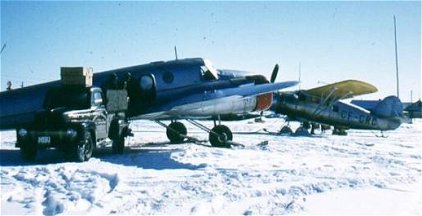
Anson and Norseman (?)
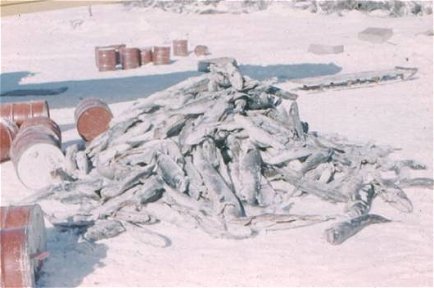
Fish cargo
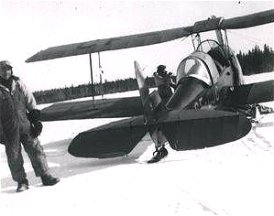
Tiger Moth post war freighter service
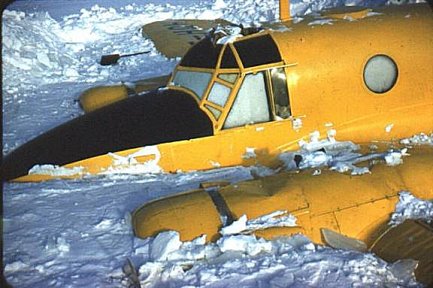
Anson post war freighter through thin ice
Karl Kjarsgaard
As I had something to do with the recovery of Halifax
NA337 at Trenton I thought I would send along some exciting photos of the
move of NA337 from the rebuild shop to the new display building on OCT
16/2004
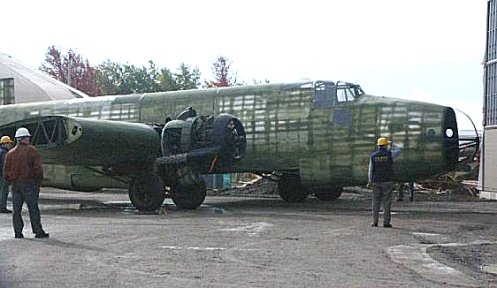
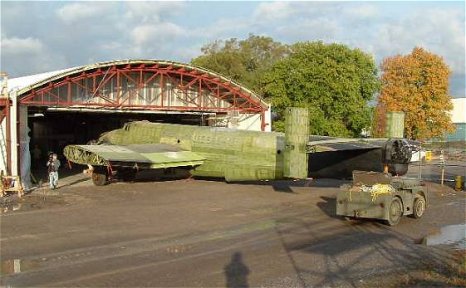
There can be no finer symbol of our military
heritage and history that the Handley Page Halifax of the Royal Canadian
Air Force. 28, 000 of the 39,000 bombing missions done by the RCAF in World
War Two were done on the Halifax bomber. Over 1000 Halifax aircraft were
used by our Canadian squadrons during this period when so many grievous
losses were experienced. Out of 100 Canadian bomber crews who started their
combat duty only 24 would finish their combat tour. The other 76 were killed-in-action,
killed-in-training, or prisoner-of-war. This was the greatest casualty
rate of any military force in Canadian history, including the army and
navy losses. The majority of our young aircrew warriors flew the Halifax.
And who had the lowest loss rate in air combat of all the Allied squadrons
of Bomber Command? The Canadians of the RCAF. Who had the highest serviceability
rate, ready for battle every night, of all the squadrons of Bomber Command?
The Canadian squadrons.
For years after I personally discovered these revelations
about this country's air force warriors I dreamed, prayed, searched, and
hoped a RCAF Halifax could be found somewhere in the world to become a
memorial to their excellence and sacrifice. In my life's journey I have
helped to find and recover an RAF Halifax from the bottom of a Norwegian
lake and recovered 3 missing RCAF aircrew and their crashed Halifax from
a Belgian swamp. I have received the invaluable training from these two
recoveries which will allow 57 Rescue (Canada, that is you and I together,
to complete our mission to locate and recover RCAF Halifax LW170 from the
deep ocean off Scotland. I hope you will understand why I believe we MUST
do this project for all the reasons above. Think of these "impossible"
technical recoveries that have been done by our people and remember that
first the impossible was converted to the difficult, and then the project
was successfully completed.
I would like all members and prospective members
of our group to please take careful note that we have had to change our
group name slightly as Industry Canada found a conflict with another corporate
name in their register. We are now officially called Halifax 57 Rescue
(Canada). Please remember that when sending in any cheques/checks for membership
fees or donations that these checks should be made out to the above NEW
name.
The Minister of Defence of England, in late October, was
asked for technical and logistical help from the MoD to help locate LW170.
Our Halifax went down in a location which today is a Royal Navy exercise
area for submarines and it is possible that LW170 has been located in the
recent past or could be detected by sonars of the RN if they feel sympathetic
to our project.
As our corporate and charitable entity has now
been officially realized the following volunteered have agreed to stand
as Directors.
James Blondeau (Ottawa) - Film Producer, responsible for
the documentary of the Halifax NA337 recovery and recovery of Halifax LW682
with her missing crew.
Chris Charland (North Bay) - respected Military Historian
and World War Two researcher of the Allied air forces, 12 years as USAF
public affairs officer, published author, licensed
Pilot.
Clarence Simonsen (Airdrie, Alberta) - World authority
on aircraft Nose Art, Allied air force researcher, and RCAF historian
George Rosskopf (Ottawa) - Warbird rebuilder, talented
aircraft machinist, and former Halifax NA337 structural engineer, licensed
pilot
These talented people have agreed to help HALIFAX 57 RESCUE
(CANADA) in these formative months as we begin our historic quest for RCAF
Halifax LW170. In the middle of 2005, subject to the formalization of our
group, we will be appointing officers and executive according to our needs
and manpower required.
I am hopeful that in the province of Alberta, in light of
the fact that Nanton will be the home for the Halifax, that we can find
the support we need to get the project rolling.
Project progress report soon on our website at www.57rescuecanada.com
with some new developments being announced.
Best regards to those resident rebels of the air force,
the air gunners!
Cheers, Karl Kjarsgaard
Halifax 57 Rescue (Canada)
Project Manager
Don Macfie
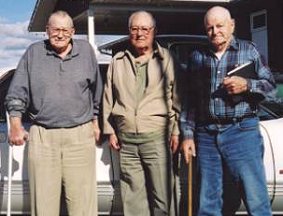
L to R Al Colquboren, Phil Owen,
Don Macfie.
On Sept. 30, 2004, the remnants of a draft of 28 recruits
that left North Bay Ont. on January 3, 1941, as WAG trainees for the RCAF,
met at Sundridge Ont. Legion to open up some rusty hangar doors.
Of this group 27 became aircrew, most became WAG’s and
graduated from the 16th. And 18th. Entries at #1 Wireless School at Montreal.
Two did become Spitfire pilots. Eleven were killed in action overseas,
three got DFCs, one received a DFM, and one became an acting Wing Commander.
In the above picture on the left, Al Colquboren from Sturgen
Falls Ont., now visiting from South Africa, after some behavioural cleansing
at the Detention Centre at Trenton, Ont., became a Straight AG. When Al
went overseas I went to Debert, NS. It wasn’t long before some news filtered
back from overseas that Al had beaten up six London Bobbies. But now we
have the straight Gen right from the horse’s mouth – it took six London
Bobbies to beat him up and he has a scar on top of his head to prove it,
as well as an entry on his Conduct Sheet to show he did 28 days at
Wormwood Scrubs. Anyway, he managed a 30 trip tour on Stirlings and, after
a leave at home, a second tour on Lancasters shooting down two enemy aircraft
along the way and earning the D.F.C.
Phil Owen became a remustered Bomb Aimer and did a first
tour on 419 Squadron. He came home on leave and went back to almost complete
a second tour on 419 Squadron. However, with two trips short of a second
tour he had the misfortune of having to bail out and become a P.O.W.
And Don Macfie? Well, he managed to tally up 1610 hours
in his logbook over a period of 56 months flying, with a leave home from
overseas in the middle of it – and nothing ever happened to him.
Ed’s note: You are too modest Don
SEARCH PATTERN
Carman Brown is looking for Miller W. J. Air Gunner
WO R194068 429 Squadron POW #3436 Shot down April 23/44
Email cama107@sympatico.ca
MY FATHER IN ENGLAND IS TRYING TO TRACE HIS WARTIME COMRADE
FROM RAF BOMBER COMMAND 49 SQUADRON WHO PARTED COMPANY FROM HIM ON THE
NIGHT OF 8/10 AUG 1943 WHEN THEIR LANCASTER BOMBER CRASHED IN GERMANY,
RETURNING FROM A BOMBING RUN TO MANNHEIM.
THE COMRADE'S NAME WAS SERGEANT MAURICE E SCARFE. ALTHOUGH
A US NATIONAL FROM LOS ANGELES HE WAS SECONDED FROM THE CANADIAN AIR FORCE
TO SERVE IN BRITAIN WITH THE RAF I BELIEVE HE WAS AN AIR GUNNER.
ANY INFORMATION WOULD BE GREATLY APPRECIATED.
SINCERELY
MR PHILIP G COLE
(If you can help Philip, send information to the
Editor)
From Ted Hackett
Good evening John. I had an e-mail from Norm Muffitt
who asked if you knew a chap named Allen Deller. He wrote a book
called "Kid Glove Pilot" about Coastal Command. On page 119 of that
book there is an account of how Norm’s Father was killed, apparently by
a defective fuse on some depth charges. I understand the charges
blew up the moment they hit the water. I will ask him if he has any
more photos that would interest you.
(Ed. Has anyone heard of the book “KID GLOVE PILOT”?)
tedgene@telusplanet.net
E-mail Norm Muffitt mufftoon@telusplanet.net
CORRESPONDENCE
Mr. Moyles,
I wonder if you might have a contact e-mail for the BC
Branch of your organization.
I'm the CO of 828 "Hurricane" Squadron, Royal Canadian
Air Cadets, and on May 7, 2005, our squadron and at least three others
will be dedicating a cenotaph at Boundary Bay Airport, the former RCAF
Station Boundary Bay. I gather that a good number of your members
trained with #5 OTU, and I would be honoured if any of them would be interested
in attending the event.
Sincerely,
J.M. (Jason) White
Captain
Commanding Officer
828 Hurricane RCACS
Home: 604-598-8277
Dear John and Doreene Moyles,
I have studied your website with much interest and, in
particular, the April 2004 Newsletter entitled SHORT BURSTS. There is a
letter from 'AC2 Don Macfie', who was stationed at RAF Oban in 1942, in
which he quotes extracts from his 1942 diary concerning the crash of Sunderland
W4026 on 25 August that year. I have been interested in this tragic event
ever since first reading Sarah Bradford's outstanding biography of George
VI some ten years ago. I was intrigued by the sentence on page 456: 'The
King, for some reason, was not told of his brother's death until dinner
that night.' During dinner, the King, who was at Balmoral with other members
of the Royal Family, was asked to take a phone call from the Air Minister,
Sir Archibald Sinclair. The Duchess of Gloucester, who died a fortnight
ago, was present and recorded the event in her diary, which Ms Bradford
quotes.
I have no professional interest in this matter: I am a
retired solicitor; formerly I was a partner in major British law firm (now
Addleshaw Goddard.) My father, James Gowans, served in the RAF during the
War; he gained his
wings at the No1 British Flying Training School at Terrell,
Texas. He sailed from Liverpool on New Year's Eve 1944 for Halifax, Nova
Scotia and travelled on to Texas via Montreal and Chicago. Coincidentally,
his mother's family came from Wick in Caithness, just a short distance
to the north of Eagle's Rock where the Duke's plane crashed. My father
now lives in Cyprus and is a regular visitor at RAF Akrotiri. My nephew,
Neill Gowans, is a Flight Lieutenant currently based at RAF Brize Norton.
I was brought up in Wales, and as a child in the early Sixties I vividly
remember going on board one of the last Sunderlands - then a floating
museum - at Pembroke Dock. Ever since, flying boats have fascinated me.
Accordingly, when I came across Mr Macfie's letter on
your website, I was amazed to read his diary entries for 25 and 27 August
1942 and his note of a meeting a short while later with the sole survivor
of the crash, Andrew
Jack. In all probability, Mr Macfie is one of the few
people still alive who has any direct knowledge of the crash. For many
years I have been trying to piece together the events surrounding the tragedy,
and although I am
convinced that human error was to blame - and not
sabotage - and that the bizarre allegations that Rudolf Hess was on board
are nonsense, I remain puzzled by the number of bodies recovered: the authorities
stated that
fifteen people were on the plane, and, before it was
discovered on 26 August that Andrew Jack had survived, statements had been
issued confirming that fifteen bodies had indeed been recovered at Eagle's
Rock. Moreover, as stated in recent press reports, according to Jack's
niece, Margaret Harris, Jack told his brother that there was an unauthorised
person on the flight.
I should greatly welcome the opportunity to put a few
queries to Mr Macfie. Would it be possible for you to contact him and obtain
his permission to give me his address, fax or e-mail details?
I look forward to hearing from you,
Yours sincerely,
Glyn Gowans
GLYN MACAULAY GOWANS
S'HORT D'EN PAU,
SEXTA VUELTA 6163,
S'HORTA,
07669 MALLORCA,
SPAIN
BOOK REVIEW
WATCH AND WARN A Wartime Story of Canada’s Homefront
Aircraft Detection Corps –
by Allan F. Coggon
ISBN 1-4120-3192-3
To Order:
Allan Coggon,
RR2,
Mahone Bay, NS
BOJ 2EO
Price $29.99 Can. (includes mailing and tax)
When I read Allan’s book, WATCH and WARN, it made me realize
that, where wartime knowledge was concerned, I had “tunnel vision.” I am
not alone. One of our members joined the RCAF at the age of 17 and celebrated
his 18th. birthday in a tail turret over Berlin. His knowledge of the war
was Bomber Command. In like manner, after flying off water for three and
one half years, my war was Coastal Command. Military training encouraged
this, “follow orders, don’t question authority, do your job.” This instilled
a solidarity and pride among crewmembers. I had no knowledge of what was
happening on the Home Front.
In his book Allan shows us that there were a group of
dedicated Volunteers back in Canada doing a job and, sometimes risking
their lives, in the protection of our country. The 30,000 volunteer members
of the Aircraft Detection Corps. They did far more than just identify aircraft.
These Volunteers consisted of farmers, fishermen, trappers, Hudson Bay
out post workers. Many children were recruited, as their eyesight and ability
to recognize a/c and ships were better than adults.
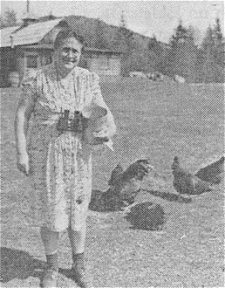
Member of Air Craft Detection Corps.
Binoculars carried at all times
To witness the lack of knowledge of what occurred on the
home front consider the following question, “what was the most highly fortified
area of the North American Continent in 1942/43?” Halifax – No; Vancouver,
No: Seattle, No. It was Sault Ste Marie, Ontario! Allan’s explanation indicates
how vulnerable Canada was to attack in this area.
This is a timely work as the thousands of Volunteers,
like we veterans, will soon be history. WATCH and WARN will help keep their
memory alive.
The work of the Volunteer was to log all aircraft seen
and report anything out of the ordinary, e.g. unidentified a/c, any a/c
appearing to be in trouble, ships at sea, flotsam and jetsam in the ocean
or washed up on shore, debris or equipment on the beaches, or suspicious
looking strangers.
The Observers soon found themselves contributing to the
war effort. In March 1941, the German battle Cruisers Scharnhost and Gneisenau
were only 350 miles South East of St. Johns, Newfoundland; Nazi submarines
were coming into the bays and coves on the East coast and dropping off
spies who, equipped with radio transmitters, could report convoy and military
movements. Submarine crews were also coming ashore to set up automatic
weather stations, or to pick up German PoWs escaping from Canadian PoW
camps ( I understand that they were not successful in the latter).
One interesting incident: a farmer Volunteer saw a man,
carrying a suitcase, approaching his farmhouse. The man wanted directions
so the farmer obliged him. After the stranger left the farmer realized
that the odour he smelt on the man was diesel fuel. He immediately phoned
the RCMP. When the stranger was taken into custody, a radio, USA and Canadian
currency, and maps of the Eastern provinces were found. After weeks on
a submarine this odour is hard to shake. This was not an isolated incident.
With the German submarines having free rein on the Atlantic
Coast; the Japanese entrenched in the Aleutians, (generating evacuation
plans for Vancouver Island); Japanese submarines along the West Coast,
and the afore mentioned threat to the Sault Ste Marie in Central Canada,
the war could have easily moved into Canada. We were fortunate that all
we experienced were the Japanese firebomb balloons.
If I was to fault Allan on any of this work it would be
his less than inclusive coverage of the Volunteers on the West Coast. Allan
flew on the East Coast for three years before going to the South East Asian
Theatre, on the other hand, I spent two years flying on the West Coast
before being transferred to the UK Theatre. So I guess you could call it
A bit of tunnel vision for each of us. The stories of these Canadian Volunteers
doing
around-the-clock duty, and their individual stories,
are fascinating.
As much of this information was considered top secret,
it was censored, and banned from publication, the average Canadian was
not aware of how close they were to the enemy.
I highly recommend this book. It is an important part
of Canadian history and, as such, should be placed in libraries across
our land and made available to the younger generation. If you don’t buy
this book, go to your local library and request them to stock it. Watch
and Warn will make a valued addition to your personal collection of wartime
memories.
Reviewed by John Moyles
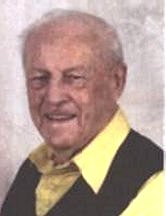 Author
Allan Coggon spent 38 years as an active pilot, obtaining his wings
with the RCAF in 1940, serving in Eastern Canada until 1943, and then doing
a tour with the RAF against the Japanese forces in South East Asia. Post
war Allan found a career flying for KLM Royal Dutch Airlines. In 1993 Allan
founded the International Aircrew Association of Nova Scotia, and has been
Editor of their Newsletter TAILWIND. In 1995 he helped form the Silver
Dart Chapter of the Canadian Aviation Historical Society in Halifax of
which he is now President.
Author
Allan Coggon spent 38 years as an active pilot, obtaining his wings
with the RCAF in 1940, serving in Eastern Canada until 1943, and then doing
a tour with the RAF against the Japanese forces in South East Asia. Post
war Allan found a career flying for KLM Royal Dutch Airlines. In 1993 Allan
founded the International Aircrew Association of Nova Scotia, and has been
Editor of their Newsletter TAILWIND. In 1995 he helped form the Silver
Dart Chapter of the Canadian Aviation Historical Society in Halifax of
which he is now President.
EDITOR’S REPORT
Remember the Mess rules of deportment? In part they said
that two topics of conversation were verboten in the Mess – sex and politics.
It has been the policy of Short Bursts Editors, right
from March 1983 when Charley Yule and Jim Patterson put out the Newsletter,
that we would not print politically divisive material.
I now break with that convention. I was moved by the following
article and felt I must share it with you:
FEWER AND FEWER VETERANS LEFT
Doug Cuthand – Regina Leader Post – Nov. 22,2004.
(Abridged)
Last week I attended a bittersweet event. The Saskatchewan
Indian Veterans Association held its annual meeting in Saskatoon so I wandered
down to meet my old friends.
Over the years, our Second World War veterans have died
off or have become infirm. It's sad to witness the passing of a generation.
Our people honoured the warriors from the battle at Cutknife Hill and Batoche.
They honoured those who went to the First and Second World War. Aboriginal
veterans were even in South Africa for the Boer war.
One example that is unique to our situation is the paternalistic
way we were treated by government. The soldiers' pay was not given to the
soldiers' wives or mothers but instead was sent to the Indian Agent.
Correspondence, since uncovered, indicates that the government
felt that Indian women could live on a lot less than white women so pay
was withheld. The story goes that the Indian Agent would give out $20 per
month and invest the rest in war bonds. After the war, when the veterans
asked what happened to their pay, it turned out that no war bonds had been
purchased and the money had been returned to the war effort. As it turned
out many of our boys fought for $20 a month.
Other veterans received their veteran's entitlements from
the Department of Veterans Affairs. These programs included housing, education
and other assistance. Our veterans' benefits were administered by the paternalistic
Department of Indian Affairs. Benefits were handed out at the whim of the
Indian Agents and the trouble makers were weeded out. As one veteran told
me, "We were kicked off the troop train and told to get back to the reserve."
Our returning veterans were given little if any help and
for years they languished on the reserves. The other veterans got assistance
that propelled them into good jobs and the post-war boom.
The bitterness remains today. A couple of years ago, the
federal government recognized this injustice and made $20,000 in compensation
available to every veteran from World War two and Korea. The only reason
the veterans accepted it was because they were simply too old to continue
the fight.
In 2005 Saskatchewan and Alberta will be celebrating their
Centennial year. Millions will be spent, many speeches made, praising our
accomplishments. However, it should also be a time of soul searching. No
longer can we say, “not my problem, let the politicians handle it.”
They won’t. We owe it to our fellow comrades to keep the memory of this
injustice alive and speak out.
OK, off the soapbox. We want to thank those who contributed
to this Page and remind Membership that there will not be a January 2005
Page. We will be back again February 1, 2005.
I wish to publicly thank my Navigator, who lives in England,
for his extremely generous donation to the Short Bursts Page. This has
been sent to our benefactors, the CATP Museum in Brandon, Manitoba. So,
chaps, don’t let a Navigator show up the Gunners, remember to pass the
hat at your next luncheon to help the CATP Museum.
Regarding the lead picture of the Catalinas, I was crewed
up on Cats for a short time and we had a Flight Engineer by the name of
Tommy Abbott from Vancouver. When starting the engines it was Tommy’s job
to sit on top of the wing between the engines with a fire extinguisher
at the ready. With the ocean swell making the ship roll, heave, tug on
the buoy chain, and the ever present rain this was not a stable position.
After the engines started and the aircraft released from the buoy, the
Engineer was supposed to slide back down the wing, enter one of the gun
blisters in the rear, and make his way to the front to help stow the gear.
Tommy couldn’t be bothered with that. He would drop down
over the front of the wing between the spinning props and enter the mooring
compartment in the nose. Ok, go back and check the picture to see the route
Tommy took. This was routine until the CO happened to be watching from
the slipway.
If anyone knows the whereabouts of Tommy Abbott, give
us a shout.
Doreene and I wish you all a merry festive season surrounded
by family and friends.
God Bless
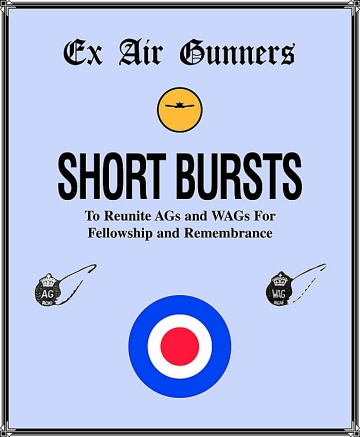

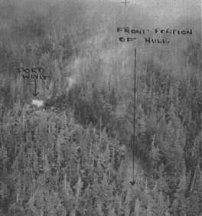
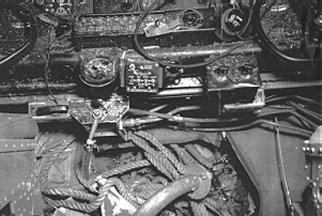
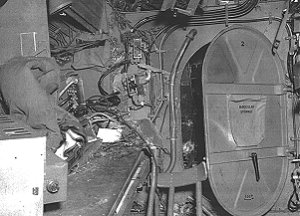
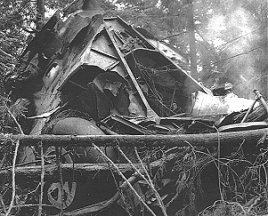










 Author
Allan Coggon spent 38 years as an active pilot, obtaining his wings
with the RCAF in 1940, serving in Eastern Canada until 1943, and then doing
a tour with the RAF against the Japanese forces in South East Asia. Post
war Allan found a career flying for KLM Royal Dutch Airlines. In 1993 Allan
founded the International Aircrew Association of Nova Scotia, and has been
Editor of their Newsletter TAILWIND. In 1995 he helped form the Silver
Dart Chapter of the Canadian Aviation Historical Society in Halifax of
which he is now President.
Author
Allan Coggon spent 38 years as an active pilot, obtaining his wings
with the RCAF in 1940, serving in Eastern Canada until 1943, and then doing
a tour with the RAF against the Japanese forces in South East Asia. Post
war Allan found a career flying for KLM Royal Dutch Airlines. In 1993 Allan
founded the International Aircrew Association of Nova Scotia, and has been
Editor of their Newsletter TAILWIND. In 1995 he helped form the Silver
Dart Chapter of the Canadian Aviation Historical Society in Halifax of
which he is now President.
